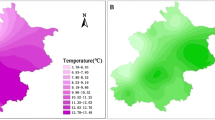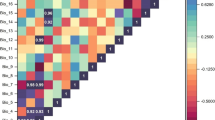Abstract
To quantitatively assess future change of evergreen broad-leaved tree species’ distributions in human-disturbed landscapes of the Korean Peninsula under climate change, potential habitats (PHs) were projected for four important evergreen broad-leaved tree species (Quercus acuta, Castanopsis sieboldii, Machilus thunbergii, and Neolitsea sericea) by species distribution models (SDMs). The distribution data (presence/absence) of the target species in Korea and Japan were used as response variables for SDMs, and climatic data were used as explanatory variables. Three general circulation models under A2 emission scenarios were used as future climate scenarios for the years 2070–2099. Potential habitats masked by land-use data (PHLUs) were projected to assess the impact of anthropogenic activities. Highly accurate SDMs were obtained for all the target species. The current PHs were decreased to 21–35 % by the anthropogenic activities. Future PHLUs for all the target species were projected to increase by 2.0–18.5 times of current PHLUs. These results suggest that all the target species are applicable as indicator species for monitoring in the Korean Peninsula, even if anthropogenic effects are incorporated. Variation of the increasing rate was caused by the differences in the response to temperature changes. M. thunbergii responded sensitively to the increase of minimum temperature of coldest month and had a largest increase in PHLUs under future climate. Therefore, M. thunbergii is considered to be most appropriate species for monitoring the changes of horizontal distributions above all focal evergreen broad-leaved tree species.




Similar content being viewed by others
Abbreviations
- WI:
-
Warmth index
- TMC:
-
Minimum temperature of the coldest month
- PRS:
-
Summer precipitation
- PRW:
-
Winter precipitation
- KAVeR:
-
Korean Atlas of Vegetation Records
- PRDB:
-
Phytosociological Relevé Database
- PHs:
-
Potential habitats
- PHLUs:
-
Potential habitats masked by land use
- NHs:
-
Non-habitats
- NHLUs:
-
Non-habitats masked by land use
References
Armonies W, Reise K (2003) Empty habitat in coastal sediments for populations of macrozoobenthos. Helgol Mar Res 56:279–287
Braun-Blanquet J (1964) Pflanzensoziologie, 3 Aufl. Springer, Wien
Burnham KP, Anderson DR (2002) Model selection and multimodel inference: a practical information-theoretic approach, 2nd edn. Springer, New York
Choi SH, Lee WK, Son YH, Yoo SJ, Lim JH (2010) Changes in the distribution of South Korean forest vegetation simulated using thermal gradient indices. Sci China Life Sci 53:784–797
Efron B (1979) Bootstrap methods: another look at the jackknife. Ann Stat 7:1–25
Elith J, Leathwick JR (2009) Species distribution models: ecological explanation and prediction across space and time. Annu Rev Ecol Evol Syst 40:677–697
Higa M, Tsuyama I, Nakao K, Nakazono E, Matsui T, Tanaka N (2012) Influence of nonclimatic factors on the habitat prediction of tree species and an assessment of the impact of climate change. Landsc Ecol Eng 21:1–10
Hijmans RJ et al (2005) Very high resolution interpolated climate surfaces for global land areas. Int J Climatol 25:1965–1978
Horikawa M, Tsuyama I, Matsui T, Kominami Y, Tanaka N (2009) Assessing the potential impacts of climate change on the alpine habitat suitability of Japanese stone Pine (Pinus pumila). Landsc Ecol 24:115–128
IPCC (2001) In: Houghton JT, Ding Y, Griggs DJ, Noguer M, van der Linden PJ, Dai X, Maskell K, Johnson CA (eds) Climate change 2001: the scientific basis, Chap 2. Cambridge University Press, Cambridge
IPCC (2007a) In: Solomon S, Qin D, Manning M, Che Z, Marquis M, Averyt KB, Tignor M, Miller HL (eds) Climate change 2007: the physical science basis. Contribution of working group I to the fourth assessment report of the intergovernmental panel on climate change. Cambridge University Press, Cambridge/New York
IPCC (2007b) In: Parry ML, Canziani OF, Palutikof JP, Linden PJ, Hanson CE (eds) Climate change 2007: impacts, adaptation and vulnerability. Contribution of working group II to the fourth assessment report of the intergovernmental panel on climate change. Cambridge University Press, Cambridge
Jones JPG (2011) Monitoring species abundance and distribution at the landscape scale. J Appl Ecol 48:9–13
Kil BS, Kim JU (1999) Syntaxonomy of evergreen broad-leaved forests in Korea. Korean J Environ Ecol 17:233–247
Kim MH (2000) Phytosociological studies on the vegetation of Cheju Island, Korea. PhD thesis, Tokyo University of Agriculture and Technology, Tokyo
Kim JW, Lee DK (2006) A study on the vulnerability assessment of forest vegetation using regional climate model. J Korean Env Res Reveg Tech 9:32–40 (in Korean with English summary)
Kira T (1977) A climatological interpretation of Japanese vegetation zones. In: Miyawaki A, Tuexen R (eds) Vegetation science and environmental protection. Maruzen, Tokyo, pp 21–30
Korean Ministry of Environment (1998) The 2nd national natural environment survey (vegetation). Ministry of Environment, Korea (in Korean)
Korean Ministry of Environment (1999) The 2nd national natural environment survey (vegetation). Ministry of Environment, Korea (in Korean)
Korean Ministry of Environment (2000) The 2nd national natural environment survey (vegetation). Ministry of Environment, Korea (in Korean)
Korean Ministry of Environment (2001) The 2nd national natural environment survey (vegetation). Ministry of Environment, Korea (in Korean)
Korean Ministry of Environment (2002) The 2nd national natural environment survey (vegetation). Ministry of Environment, Korea (in Korean)
Lee BY, Nam GH, Yun JH, Cho GY, Lee JS, Km JH, Park TS, Kim KK, Oh KH (2010) Biological indicators to monitor response against climate change in Korea. Korean J Plant Taxon 40:202–207
Manly BFJ, McDonald LL, Thomas DL, McDonald RL, Erickson WP (2002) Resource selection by animals: statistical design and analysis for field studies, 2nd edn. Kluwer, Dordrecht
Matsui T, Yagihashi T, Nakaya T, Taoda H, Tanaka N (2004) Climatic controls on distribution of Fagus crenata forests in Japan. J Veg Sci 15:57–66
Nakao K, Matusi T, Tanaka N, Hukusima T (2009) Climatic controls of the distribution and abundance of two evergreen Quercus species in Japan. Jpn J For Environ 51:27–37 (in Japanese with English summary)
Nakao K, Matsui T, Horikawa M, Tsuyama I, Tanaka N (2011) Assessing the impact of land use and climate change on the evergreen broad-leaved species of Quercus acuta in Japan. Plant Ecol 212:229–243
Newson SE, Mendes S, Crick HQP, Dulvy NK, Houghton JDR, Hays GC, Hutson AM, Macleod CD, Pierce GJ, Robinson RA (2009) Indicators of the impact of climate change on migratory species. Endang Species Res 7:101–113
Oh KK, Park SG (2003) Conservation status and restoration of evergreen broad-leaved forests in warm temperate region, Korea (II). Restoration planning of vegetation in a case study areas. Korean J Environ Ecol 17:71–82 (in Korean with English summary)
Ohsawa M (1990) An interpretation in latitudinal changes in forest limits in south and East Asian mountains. J Ecol 78:326–339
Ohsawa M (1993) Latitudinal pattern of mountain vegetation zonation in southern and eastern Asia. J Veg Sci 4:13–18
Park SJ (2007) Tectonic movement in the Korean Peninsula (I): the spatial distribution of tectonic movement indentified by terrain analysis. J Korean Geol Soc 43:368–387 (in Korean with English summary)
Parmesan C, Yohe G (2003) A globally coherent fingerprint of climate change impacts across natural system. Nature 421:37–42
Pearman PB, Guisan A, Zimmermann NE (2011) Impacts of climate change on Swiss biodiversity. An indicator taxa approach. Biol Conserv 144:866–875
Pearson RG, Dawson TP, Liu C (2004) Modelling species distributions in Britain: a hierarchical integration of climate and landcover data. Ecography 27:285–298
R Development Core Team (2011) R: a language and environment for statistical computing. R. Foundation for Statistical Computing, Vienna, Austria. ISBN 3-900051-07-0. http://www.R-project.org/
Sakai A, Weiser CJ (1973) Freezing resistance of trees in North America with reference to tree regions. Ecology 54:118–126
Swets J (1988) Measuring the accuracy of diagnostic systems. Science 240:1285–1293
Tanaka N (2007) PRDB (Phytosociological Relevé Data Base). http://www.ffpri.affrc.go.jp./labs/prdb/index.html. Accessed June 2011
Tanaka N, Nakazono E, Tsuyama I, Matsui T (2009) Assessing impact of climate warming on potential habitats of ten conifer species in Japan. Glob Environ Res 14:153–164
Tanaka N, Nakao K, Tsuyama I, Higa M, Nakazono E, Matsui T (2012) Predicting the impact of climate change on potential habitats of fir (Abies) species in Japan and on the East Asia continent. Proc Environ Sci 13:455–466
Tsuyama I, Nakao K, Matsui T, Higa M, Horikawa M, Kominami Y, Tanaka N (2011) Climatic controls of a keystone understory species, Sasamorpha borealis, and an impact assessment of climate change in Japan. Ann For Sci 68:689–699
Tsuyama I, Horikawa M, Nakao K, Matsui T, Kominami Y, Tanaka N (2012) Factors controlling the distribution of a keystone understory taxon, dwarf bamboo of the section Crassinodi, on a national scale: application to impact assessment of climate change in Japan. J For Res 17:137–148
Wood SN (2006) Generalized additive models: an introduction with R, 66. CRC, Boca Raton
Yun JH, Hukusima T, Kim MH, Yohsikawa M (2011a) The comparative studies on the distribution and species composition of forest community in Korea and Japan around the East sea. Korean J Environ Ecol 25:327–357 (in Korean with English summary)
Yun JH, Kim JH, Oh KH, Lee BY (2011b) Distributional change and climate conditions of warm-temperate evergreen broad-leaved trees in Korea. Korean J Environ Ecol 25:47–56 (in Korean with English summary)
Yun JH, Nakao K, Park CH, Lee BY, Oh KH (2011c) Change prediction for potential habitats of warm-temperate evergreen broad-leaved trees in Korea by climate change. Korean J Environ Ecol 25:590–600 (in Korean with English summary)
Zweig MH, Campbell G (1993) Receiver-operating characteristic (ROC) Plots: a fundamental evaluation tool in clinical medicine. Clin Chem 39:561–577
Acknowledgments
This research was supported by grants from the species distribution prediction research project of the National Institute of Biological Resources of the Ministry of the Environment, Korea and the Environmental Research and Technology Development Fund (S-8) of the Ministry of the Environment, Japan.
Author information
Authors and Affiliations
Corresponding author
Electronic supplementary material
Below is the link to the electronic supplementary material.
About this article
Cite this article
Yun, JH., Nakao, K., Tsuyama, I. et al. Does future climate change facilitate expansion of evergreen broad-leaved tree species in the human-disturbed landscape of the Korean Peninsula? Implication for monitoring design of the impact assessment. J For Res 19, 174–183 (2014). https://doi.org/10.1007/s10310-013-0401-6
Received:
Accepted:
Published:
Issue Date:
DOI: https://doi.org/10.1007/s10310-013-0401-6




